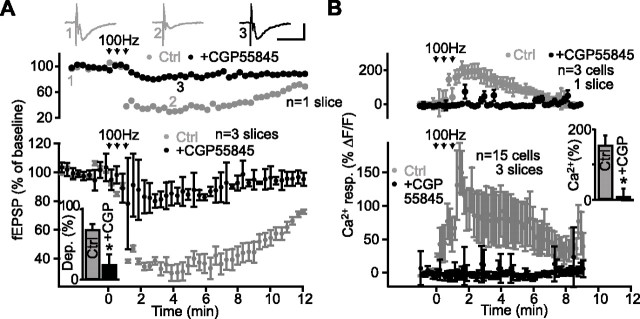Figure 6.
GABAB receptor activation is necessary for heterosynaptic depression. A, Data from a single slice (top panel) and for all slices (bottom panel; n = 3 slices) showing changes in fEPSP amplitude as percentage of baseline before, during, and after tetanic stimulation of an independent pathway (arrows) (3 trains at 100 Hz for 1 s; 30 s intervals) in paired control experiments (gray) and in the presence of the GABAB receptor antagonist CGP55845 (2 μm; black). Summary bar graph (inset) shows that heterosynaptic depression was reduced significantly by the GABAB receptor antagonist (Student’s paired t test; *p < 0.001). Top panel insets show examples of fEPSPs before (1) and during (2) heterosynaptic depression in control and in the presence of CGP55845 (3). Calibration: 1 mV, 25 ms. B, Relative increase (mean ± SEM) in fluorescence for glial cells in a single slice (top panel; n = 3 cells; same slice as in A) and for all slices (bottom panel; n = 15 cells, 3 slices) before, during, and after tetanic stimulation in control and in the presence of CGP55845 (2 μm; same experiments as in A). Summary bar graph (inset) shows the rise of Ca2+ in glial cells elicited by tetani that was blocked by CGP55845 (Student’s paired t test; *p < 0.01). Error bars indicate SEM. Ctrl., Control; resp., response.

